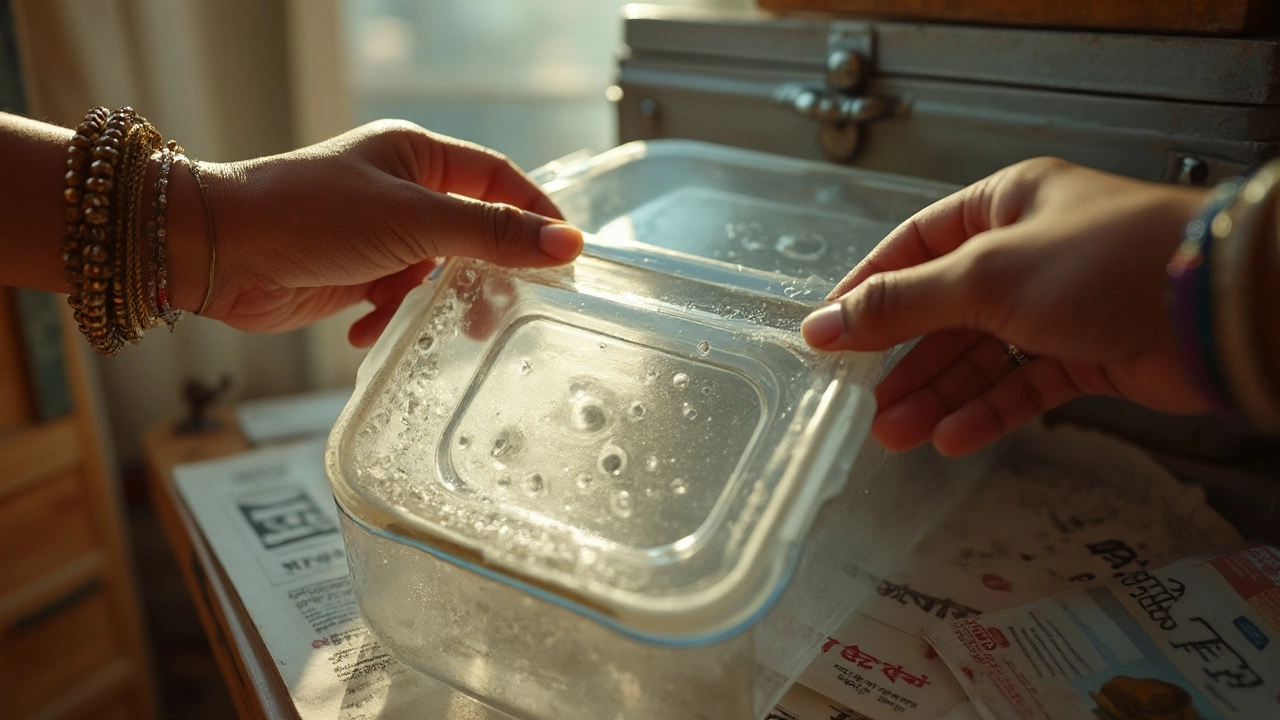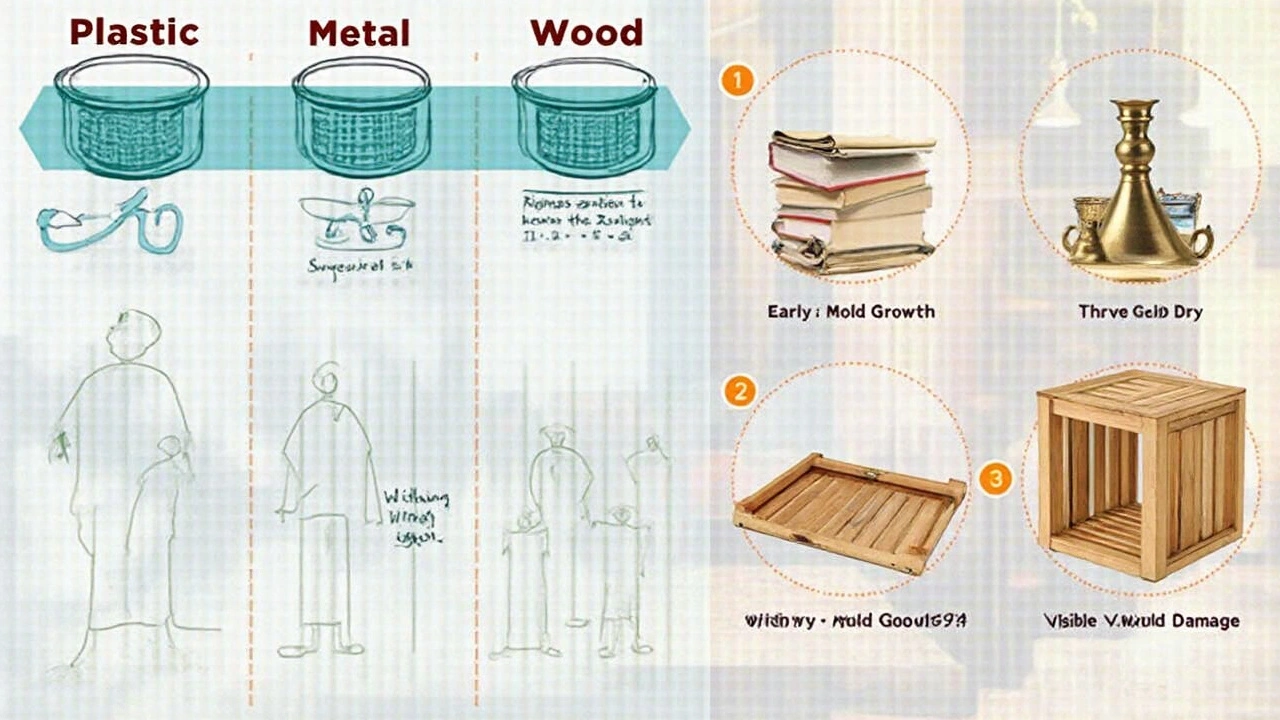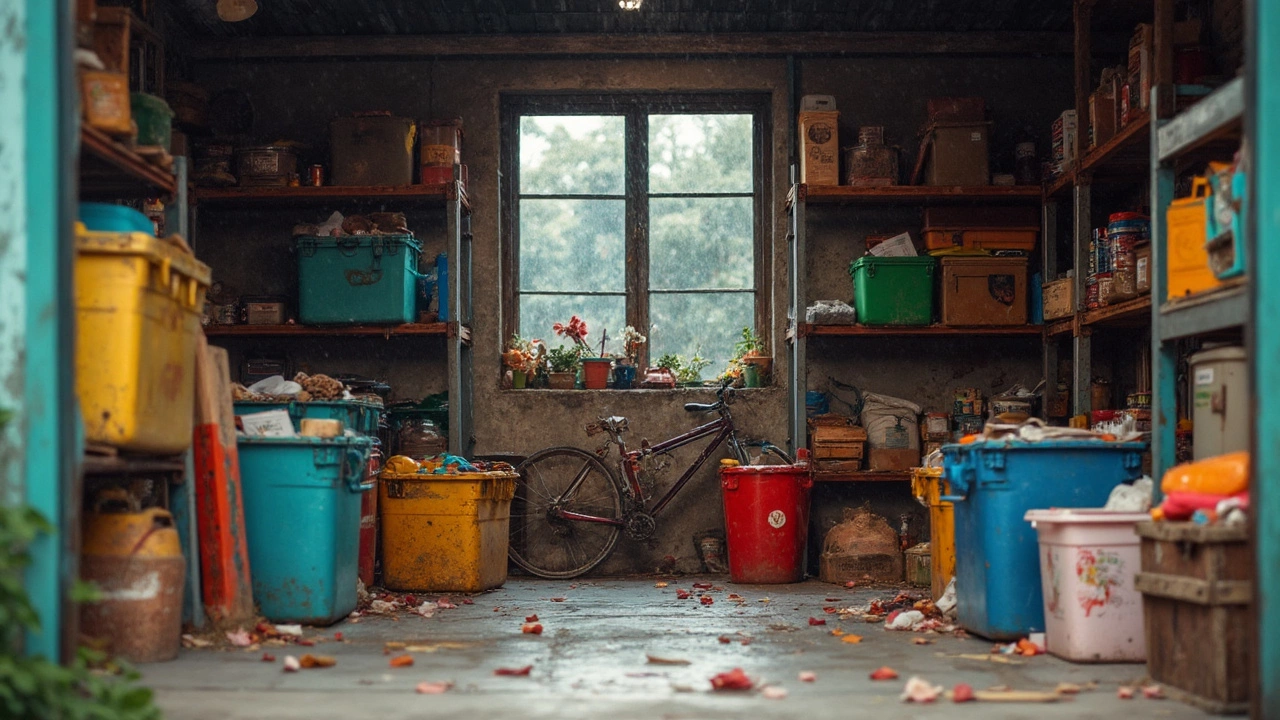You'd be surprised how fast a storage container can turn into a mold factory if moisture gets trapped inside. Even ones that seem airtight aren't totally safe if you toss in something damp or stash the box in a humid basement.
Plastic bins are popular because they're cheap and easy to stack, but if you don't dry your stuff before closing the lid, you might open it later to find your favorite shirt covered in fuzz. Wood and cardboard are even worse, since they actually soak up water. Mold just loves those materials.
But here's the thing—most mold problems start with us, not the container. Wet shoes after a rainy day? Tossing them into a closed bin is basically sending an invite to mold. Storing containers in a stuffy attic or a basement with leaky pipes? Mold will thank you.
- Why Mold Grows in Storage Containers
- Types of Containers and Mold Risk
- Signs Your Container Might Be at Risk
- Easy Tips to Prevent Mold
- What to Do If Mold Shows Up
Why Mold Grows in Storage Containers
Mold isn’t picky—it just needs the right mix of moisture, warmth, and something to munch on. Sealed up spaces like storage containers can turn into a paradise for mold if even a tiny bit of water gets locked inside. Most plastic and even tightly sealed boxes aren’t actually designed to keep out humidity forever. Over time, small leaks or condensation from temperature changes can sneak in.
If anything you stick in the container is damp—like clothes after a sweaty workout, a towel from the beach, or paperwork that got caught in a drizzle—mold spores floating around in the air get the perfect setup to start growing. Once they find moisture and food, those little spores multiply fast. They especially love paper, cardboard, leather, and cotton, but mold will settle in on nearly anything organic, even dust.
Temperature swings are another big trigger. If you store containers somewhere that gets cool at night but warm during the day, like a garage, you’ll often get condensation inside the box. It forms on the lid or walls and can drip down onto your stuff. That water is all mold needs to get going.
Airflow is the final piece. Most closed containers don’t let much air in or out. Trapped air means trapped moisture, and once the space gets damp, it takes ages to dry out. That’s why you’ll sometimes smell something funky before you ever see the first mold spot.
Types of Containers and Mold Risk
Not all storage containers are created equal when it comes to keeping mold away. The main thing mold needs is moisture, so the material your container is made from makes a big difference.
Plastic storage containers are probably the most common. They don’t actually feed mold, but if you seal in even a tiny bit of moisture—like a damp towel or a sweaty sneaker—mold will happily grow on the contents inside. Plastic bins with tight lids do block outside humidity, but once moisture is trapped inside, it’s stuck. Some folks like to add silica packets or little moisture absorbers to cut down risk.
Cardboard boxes are super convenient but bad news for long-term storage. Cardboard actually absorbs moisture from the air, and once it’s wet, mold goes to town. This is why you see so many musty-smelling cardboard boxes in attics and basements. These shouldn’t be used where it's damp or for anything you care about staying fresh.
Wooden chests and trunks look nice, but wood acts kind of like a sponge. If there’s humidity in the air or the container is stored against a cold basement wall, it’ll soak it right up. Over time, mold can start not just on your stuff but on the container itself.
Metal containers, like old-school trunks or ammo boxes, don’t feed mold either. But, unless they’re sealed perfectly, condensation can collect inside, especially with temperature swings. Plus, metal can rust, which just adds to the mess.
- Plastic: Best for dry stuff, keep them closed after adding moisture absorbers.
- Cardboard: Cheap, but risky—avoid for anything valuable or for use in humid spaces.
- Wood: Looks cool, but risky in cellars or garages where the air isn’t controlled.
- Metal: Sturdy, but needs really good seals and dry conditions to work well.
If you want your storage game to be mold-free, pay attention to both the type of container and where you put it. Mold risk goes way up if you combine the wrong container with a damp environment.

Signs Your Container Might Be at Risk
You don’t have to wait until your stuff is ruined to figure out something's wrong inside your storage container. Spotting trouble early makes it way easier to keep things mold-free. Here’s what you should look for if you want to avoid total cleanup mode.
- Musty Smell: If you get a whiff of that "old basement" or "wet towel" smell when you crack open your bin, that's a giant red flag. Mold has a pretty unique odor, and sometimes you’ll notice it before you see actual mold.
- Dampness or Condensation: If the sides or lid of your plastic container feel wet inside, or you see little water beads, your stuff is soaking in the perfect mold party zone.
- Discoloration: Mold can show up as black, green, or even white fuzzy spots. Pay attention to corners, fabric folds, and the grooves of your container where junk collects.
- Warped or Swollen Material: Cardboard or wood containers that start to bulge or change shape are usually absorbing moisture (and mold loves that).
- Sticky or Slimy Feel: Sometimes, you’ll touch an item or the inside wall of a bin and it feels gross—like it’s sticky or even a little slimy. That’s not normal. Mold is probably starting to grow.
Here's how different containers and environments stack up when it comes to mold risk:
| Container Type | Environment Condition | Mold Risk Level |
|---|---|---|
| Plastic Bin (with dry contents) | Cool & dry | Low |
| Plastic Bin (with damp contents) | Humid/basement | High |
| Cardboard Box | Uninsulated garage | High |
| Wooden Chest | Bedroom closet | Medium |
If you see any of these signs or know you’ve put a container somewhere damp, don’t wait. Open it up, air things out, and fix the problem before it gets ugly. Saving your stuff is way easier than battling established mold.
And remember, if you smell something musty, your storage containers are probably already at risk. Act fast for the best shot at rescuing what’s inside.
Easy Tips to Prevent Mold
If you want to keep your stuff safe, you have to keep mold out of your storage containers. It doesn't take fancy gear—just some simple habits and smart moves make a huge difference.
- Check for moisture before packing: Even a slightly damp shirt or pair of shoes can get moldy in a few days. Dry everything all the way before it goes in.
- Pick the right containers: Plastic or metal is best. Avoid cardboard—it's a mold magnet if your basement or attic gets even a bit humid.
- Airflow matters: Don't shove containers right up against the wall. Some space lets air move and helps stop mold from getting comfy.
- Use moisture absorbers: Silica gel packs and charcoal bags soak up extra moisture. They're super cheap and easy to drop into each bin.
- Store off the ground: Put bins on shelves or pallets so they're away from leaks or puddles if your basement floods.
- Keep your space dry: Dehumidifiers and fans work wonders, especially in basements that always feel damp.
"Storing items when they’re totally dry and regularly checking containers are the two biggest ways you can prevent mold problems," says the Environmental Protection Agency (EPA).
An overlooked fact: Mold can start growing in as little as 24 to 48 hours if things are damp, according to the Centers for Disease Control and Prevention (CDC). So, don’t procrastinate on drying out laundry or sports gear before packing.
| Container Type | Chance of Mold (if damp inside) |
|---|---|
| Plastic Bin | Low to Medium |
| Metal Bin | Very Low |
| Cardboard Box | High |
| Wooden Chest | Very High |
Want bonus protection? Wipe the inside of your bins with a bit of vinegar—just enough to discourage mold, not enough to stink up your stuff.
Stay on top of these basics and your storage containers will stay fresh—no nasty surprises when you open them months later.

What to Do If Mold Shows Up
If you crack open your storage container and spot mold, don’t panic—but don’t ignore it either. Mold isn’t just gross; it can actually ruin clothes, books, and anything it touches. Plus, breathing in mold spores is bad news, especially for folks with allergies or asthma.
The best move? Act fast. Here’s what you should do if you find mold in your container:
- Take the container outside to keep spores out of your home.
- Use gloves and, if possible, a mask—mold isn’t something you want to mess with bare-handed.
- Empty everything out. Separate the things you can wash from what you might need to toss.
- Scrub the container itself with a mix of hot water and soap. For tough mold, a bit of white vinegar or a bleach solution (1 cup bleach per gallon of water) works great. Let it sit for a few minutes before rinsing.
- Dry the container completely. Even a little leftover moisture can start the whole cycle again.
For clothes or fabric, wash them in hot water or according to their care label. For items you can't wash—like books—try wiping them with a barely damp cloth and letting them dry fully in sunlight. Some things just can’t be saved if the mold goes deep, so don’t risk your health.
Check out this quick rundown of cleaning solutions recommended for common storage container materials:
| Container Material | Best Cleaning Solution | Drying Method |
|---|---|---|
| Plastic | Soap & water, vinegar, or bleach | Air dry in sunlight |
| Wood | Vinegar & water (no bleach) | Sunlight, then wipe with dry towel |
| Cardboard | Toss if heavily moldy | Replace, not worth saving |
Once you’ve saved what you can, figure out what went wrong: Was something damp inside? Was the container sitting somewhere humid? Fixing the root problem makes all the difference next time you use storage containers.

